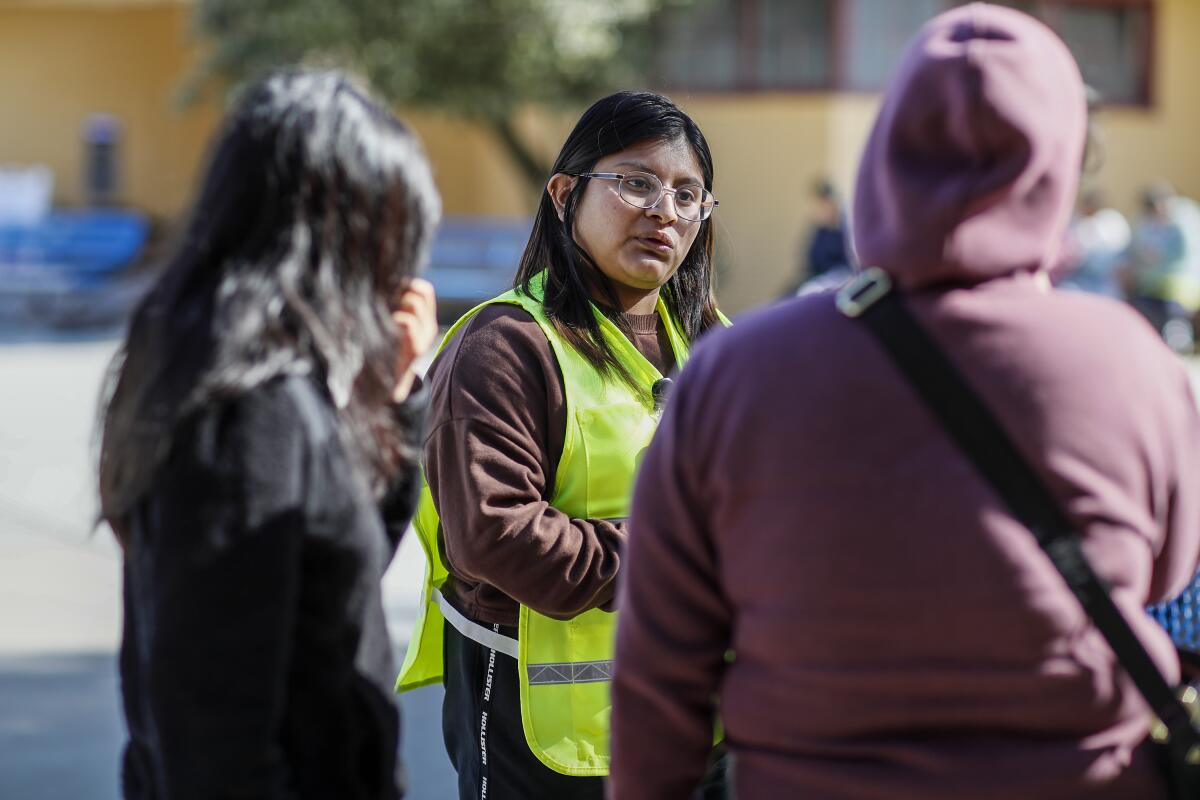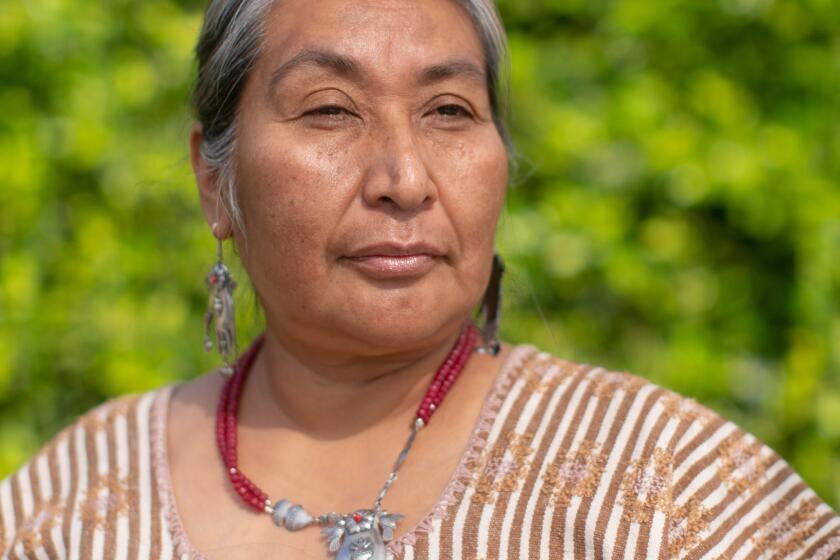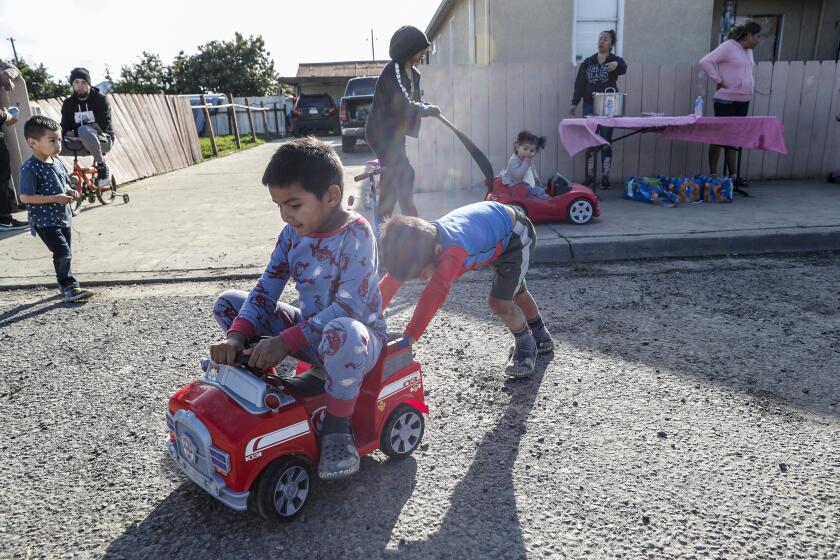Amid a disastrous flood, interpreters are a lifeline for Indigenous farmworkers

- Share via
WATSONVILLE, Calif. — Inside an evacuation center at the Santa Cruz County Fairgrounds, Maria Adolfo-Morales and a disaster service volunteer listened to a woman describe her concerns in the Mixteco language.
The woman and her three children had been staying at the center for a week, after a broken levee flooded the farming town of Pajaro and forced residents to flee.
Adolfo-Morales, a 22-year-old community healthcare worker, interpreted what the woman said into English, then rendered the volunteer’s responses into Mixteco, one of several Indigenous languages spoken in southern Mexico.
The woman’s inquiries echoed those of other displaced residents: How do I apply for food assistance? How do I apply for financial assistance?
Many of Pajaro’s agricultural workers are Mixteco speakers who are not fluent in English or Spanish. Adolfo-Morales and other interpreters have been a lifeline for them as they figure out how to survive after losing their homes and livelihoods.
An estimated 170,000 Indigenous Mexican farmworkers live in California, contributing to its booming economy. That number does not take into account non-agricultural jobs, nor does it include Indigenous immigrants from Guatemala, Nicaragua, Ecuador and Peru. Researchers say 6 in 10 farmworkers in the state are Indigenous.
Despite previous disasters — the Thomas fire, the COVID-19 pandemic — state and local officials have yet to fully include this growing population into their planning, often relying on nonprofits to communicate basic information.
With different languages in the mix, and climate change likely to spur more extreme weather, community organizers say more needs to be done.
And now, a week after many Pajaro residents have gone home, they will need to navigate complicated bureaucracies to get the help they need to rebuild their lives, which can be monumentally difficult even for English and Spanish speakers.
“The language barrier, coupled with the economic situation that they’re in, you’ve got a lot of people trying to process and make sense of what has happened and is happening to them,” said Erica Padilla-Chavez, executive director of the Second Harvest Food Bank Santa Cruz, which was among the nonprofits providing language assistance at the fairgrounds shelter.
When evacuations began in Pajaro on March 10, a coalition of grassroots organizations, well-prepped by the pandemic, came together to help Indigenous farmworkers, said MariaElena De La Garza, executive director of the Community Action Board of Santa Cruz County.
De La Garza said her organization and others, including the food bank, created a rotation of staff, contractors and volunteers who speak Mixteco, Triqui and Zapoteco, as well as Spanish, on four- to five-hour shifts at the fairgrounds shelter, which housed more than 300 evacuees.
Because of variations within each Indigenous language, De La Garza also recruited residents and workers from the community to help interpret.
Arcenio López, executive director of Mixteco/Indigena Community Organizing Project, said there are more than a dozen variants of the Mixteco language in Pajaro. Most residents, he said, are from Oaxaca and Guerrero.
Mixteco is also spoken in the states of Michoacán and Puebla.
After the levee broke, community organizers worked with Monterey County officials to provide dozens of interpreters and volunteers to assist families at local shelters and evacuation centers.
“To have Indigenous interpreters at the fairgrounds as a priority, that is new for us,” De La Garza said. “We’ve learned through the pandemic the importance of ensuring that the systems that are set up to be responsive are able to reach the communities that are most impacted.”
Luis Alejo, chair of the Monterey County Board of Supervisors, said the county plans to make Indigenous interpreters an integral part of the services it provides to residents, eventually including courtrooms and the police and fire departments.
“This has to be part of how we deliver emergency services,” he said. “We need to expand that to other services that the county provides too.”
On Adolfo-Morales’ first day at the evacuation center, she explained to Maria Lopez how to get food, clothing and financial assistance.
Until then, Lopez had relied on her three sons to tell her what officials were saying. Her sons speak Spanish and little English, making communication even more difficult.
Lopez, 54, said she was confused about the evacuation orders. She felt sad and frustrated not being able to understand fire and police officials or ask questions.
“My children would only tell me we needed to leave our home,” Lopez said in Mixteco while Adolfo-Morales interpreted.
Lopez wondered what she would face when she returned home. They had left with only the clothes on their backs. She and her husband worried about not having work in the strawberry fields, which were flooded, and not being able to pay their $2,500 monthly rent and other bills.
Lopez was one of three Mixteco speakers Adolfo-Morales helped that Thursday afternoon. She said that sometimes her ability to communicate was limited by the diversity of Indigenous languages — there are dozens of variations of Mixteco, often revolving around people’s hometowns. At times, she struggles to interpret English words that don’t exist in Mixteco, such as medical and legal jargon.
Adolfo-Morales grew up interpreting and translating for her family. But at school, some students taunted her in Spanish, calling her “little Oaxacan girl” and stringing gibberish words together in a Mixteco accent, she said.
“It was offensive to me, but I’ve learned to embrace and love my culture now,” she said
When she learned about the L.A. City Hall audio leak scandal and what a council member said about Oaxacans, she felt disappointed and remembered the bullying she experienced in school.
‘I thought we had made great progress in the last three years in gaining recognition,’ said one Oaxacan, who criticized remarks by Nury Martinez.
Dori Rose Inda, chief executive of Salud Para La Gente, said the pool of Indigenous translators has changed over the last few decades.
Before, many bilingual people lacked legal status and couldn’t be employed.
Now, as the children of Indigenous farmworkers become adults, it’s not uncommon to meet young people in their 20s like Adolfo-Morales who speak English, Spanish and Mixteco.
“I’m meeting young people who speak three languages,” she said. “It cannot happen fast enough.”
Among them is 21-year-old Edward Salvador, who was born in Watsonville and also volunteered at the fairgrounds. He said that evacuees were often surprised when they asked him questions and he responded in their language.
“I’m sure it’s a relief for them to be able to communicate their needs in their language,” he said.
Like Adolfo-Morales, Salvador interpreted for his parents at doctor’s appointments and filled out forms for them that were provided only in English or Spanish. After experiencing firsthand the lack of resources available to families like his, Salvador decided to become a certified interpreter.
At the fairgrounds, Maria Martinez wore the bright yellow vest that marked her as an interpreter. Above “Maria M.,” her name tag read “Mixteco interpreter” in English.
After three days, Martinez said that people recognized her and approached her to ask for help in Mixteco.
As an interpreter for the Pajaro Valley Unified School District, Martinez was there to help families with paperwork related to school enrollment.
After a flood struck Pajaro, children have been displaced, with families living out of cars, sleeping in emergency shelters or moving out of Monterey County to stay with relatives.
But often, she was flagged down by people who needed help with food, laundry and the shelter’s on-site clinic.
“A lot of the families here need support,” she said.
Community organizers are frustrated that local governments have not done more to address the language needs in the Central Valley. Still, they say some progress has been made.
They cite the interpreters at the fairgrounds, as well as televised news conferences in which Monterey County officials provided emergency response information in English, Spanish and Mixteco.
Leonor Mendoza was the Mixteco interpreter at one of the news conferences. It was important for the Mixteco community to receive vital information — and hearing their native tongue in an official setting made them feel visible, she said.
Still, she worried that other languages were not included.
“We should have done it in multiple [Indigenous] languages so as to not leave others out,” Mendoza said. “So, I felt a little bit frustrated, but I also told myself this was a step in the right direction. We’ve got a foot in the door, and this was a good thing.”
Mendoza had grown up without learning Mixteco — her parents decided not to teach her because they feared discrimination, which is common against Indigenous people both in Mexico and the U.S.
Then, at 9, she returned to San Martín Peras, Oaxaca, unable to speak to any relatives except her grandfather, who knew Spanish. She eventually picked up Mixteco from him.
At 13, she migrated to the U.S. with her parents, chasing strawberry work between Oxnard and Salinas. By then, she was already interpreting for her parents, including when her mother suffered a stroke while crossing the border.
When the pandemic hit, she volunteered to interpret for Indigenous families.
She said people recognize her from the news conference: “You’re that lady from TV,” they say.
She hopes that they, and their children, see her as a Mixtec woman who is proud to speak their language.
“I think that moment served a purpose: that families should keep teaching their language to the next generation for them to pass on,” she said.
More to Read
Sign up for Essential California
The most important California stories and recommendations in your inbox every morning.
You may occasionally receive promotional content from the Los Angeles Times.

















